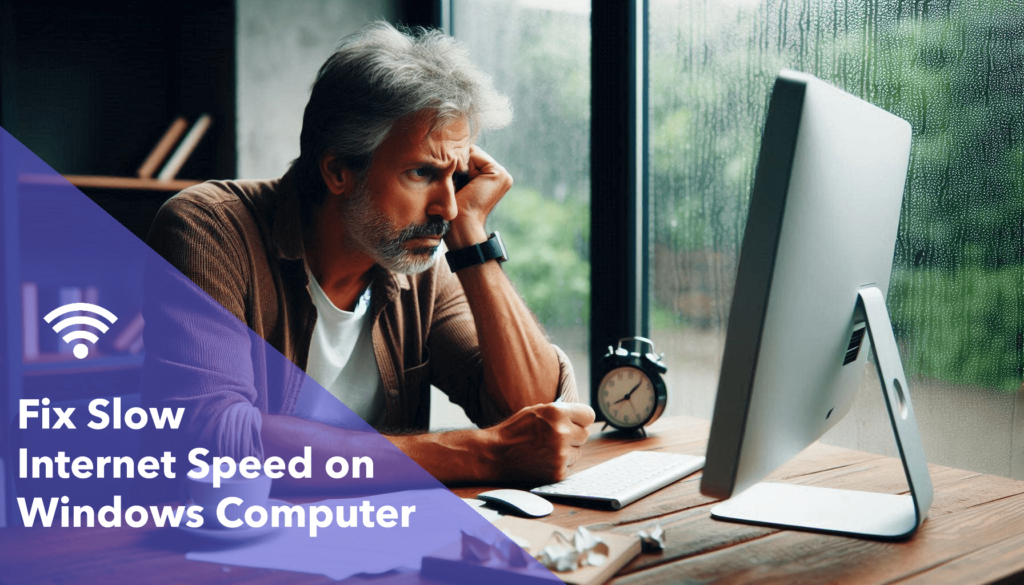Are you tired of sluggish internet dragging down your Windows experience? While other devices seem to fly, your Windows PC feels stuck in the slow lane. Fear not, fellow strugglers! This guide will equip you with the knowledge to permanently fix those frustrating internet problems.
Important Note: This guide tackles slow internet speeds specifically on your Windows machine. If other devices on your network are also slow, the issue is likely with your internet service provider (ISP).
Step 1: Update Your Network Drivers
Outdated network drivers can significantly impact your internet speed. Here’s how to update them:
- Press the Windows key and type “device manager.”
- Locate “Network adapters” and expand the section.
- Right-click on your Ethernet or Wi-Fi adapter and select “Update driver.”
- Choose “Search automatically for updated driver software” to let Windows find the latest drivers.
- Repeat steps 3 and 4 for both your Ethernet and Wi-Fi adapters (if applicable).
Step 2: Fine-Tune Network Adapter Settings
Next, we’ll adjust some settings within your network adapter properties:
- Open the Control Panel (search for “control panel” in the Windows search bar).
- Go to “Network and Sharing Center” and click on “Change adapter settings.”
- Right-click on your network adapter (Ethernet or Wi-Fi) and select “Properties.”
- Click on the “Configure” button.
- Navigate to the “Advanced” tab.
- Locate the setting called “Speed & Duplex” and change it from “Auto Negotiation” to “100 megabits and Full Duplex” (Note: In some cases, this might need to be adjusted).
- Click “OK” to save the changes. (Caution: Usually, “Auto Negotiation” is preferred, but in some situations, this manual setting can improve performance.)
Step 3: Disable Offload Settings (Optional)
Within the network adapter properties (step 2.3), you’ll find settings related to offloading. These can sometimes cause conflicts. Try disabling them to see if it improves your internet speed:
- Go to the “Advanced” tab in the network adapter properties.
- Look for settings like “Large Send Offload” or “IPv4 Checksum Offload.”
- Disable these settings and click “OK” to save the changes.
Step 4: Renew Your IP Address
An outdated IP address can also contribute to slow internet speeds. Here’s how to renew it:
- Open the Command Prompt as administrator (search for “command prompt” and right-click, select “Run as administrator”).
- Type the following command and press Enter: netsh int ip reset (you’ll need to restart your computer for this change to take effect).
- Type the following command and press Enter: ipconfig /release
- Then, type this command and press Enter: ipconfig /renew
- Lastly, type this command and press Enter: ipconfig /flushdns
Step 5: Switch to Alternative DNS Servers
Sometimes, using alternative DNS servers can improve internet speed. Here’s how to set Google’s preferred DNS servers:
- Open the Control Panel and go to “Network and Sharing Center” -> “Change adapter settings.”
- Right-click on your network adapter and select “Properties.”
- Double-click on “Internet Protocol Version 4 (TCP/IPv4).”
- Select “Use the following DNS server addresses.”
- In the “Preferred DNS server” field, enter: 8.8.8.8
- In the “Alternate DNS server” field, enter: 8.8.4.4
- Click “OK” to save the changes.
Bonus Tip: Streamline Startup Apps
Background applications can consume resources and slow down your internet. Let’s disable unnecessary startup apps:
- Press Ctrl + Shift + Esc to open the Task Manager.
- Click on the “Startup” tab.
- Disable any programs you don’t recognize or that aren’t essential for startup. (Important: Be cautious about disabling programs you’re unfamiliar with).
Still Struggling?
If the steps above don’t solve your issue, consider resetting your network settings. This will erase any custom configurations and restore them to defaults (proceed with caution as this action cannot be undone). Remember, If these solutions don’t work, contact your ISP for help.
Quick Look: 3 Steps To Speed Up Windows
Frequently Asked Questions
Ques 1: Why is my internet only slow on my Windows PC and not on other devices?
Ans: If only your Windows PC is slow, outdated drivers or incorrect settings may be the cause. Other devices on your network might have updated software and optimized settings. Follow the steps in this guide to update your drivers and fine-tune your settings.
Ques 2: How often should I update my network drivers?
Ans: It’s good to check for network driver updates every few months. You should also update them whenever you experience internet speed issues. Regular updates ensure your drivers are optimized for the best performance.
Ques 3: Can antivirus software slow down my internet speed?
Ans: Yes, some antivirus software can slow down your internet speed. They may scan all incoming and outgoing data, which can create a delay. Make sure your antivirus software is up-to-date and consider temporarily disabling it to see if your speed improves.
Ques 4: What should I do if updating drivers and changing settings don’t work?
Ans: If updating drivers and changing settings don’t help, try resetting your network settings. This can resolve hidden issues. Also, check with your ISP to ensure there are no outages or issues on their end. They might need to upgrade your plan or replace your modem/router.
Ques 5: How do I know if my internet speed issue is with my ISP?
Ans: To see if your ISP is the problem, connect another device to your network and check its speed. If all devices are slow, contact your ISP. They can check for outages, perform line tests, and offer solutions like upgrading your service or equipment.
Further Resources to fix Internet Speed:
Watch the original video by Indigo Software and permanently fix slow internet speed on windows computer

